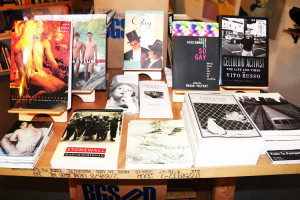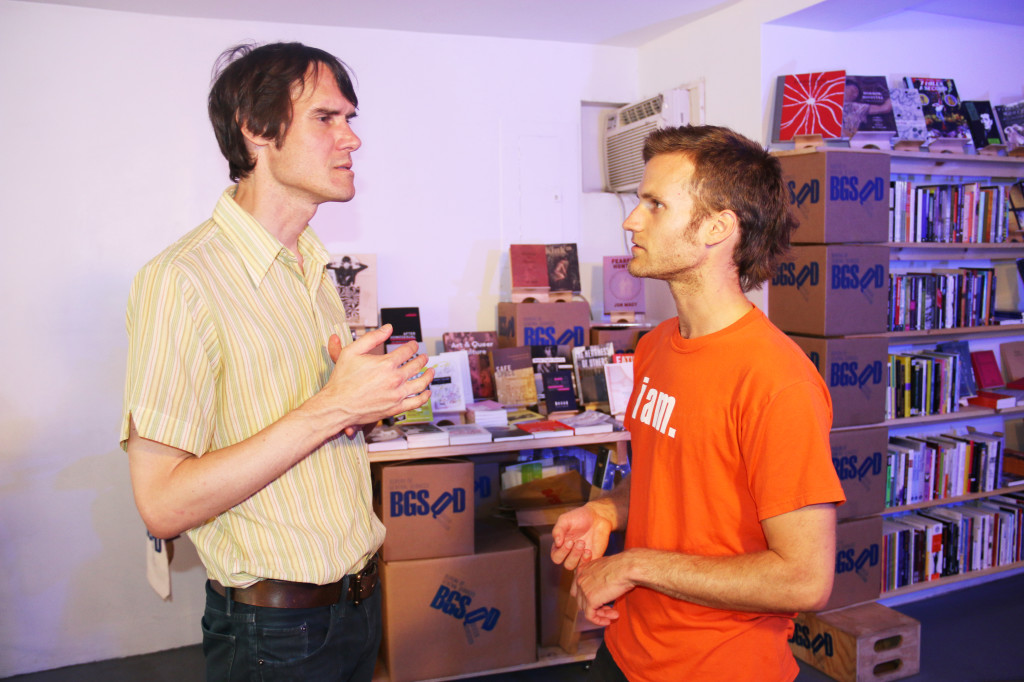Photography by Sophie Sotsky
Author| Sophie Sotsky
From June 11 through June 14 handfuls of queer and like-minded individuals gathered on Manhattan’s Lower East Side to participate in a series of six workshops organized under this heading.
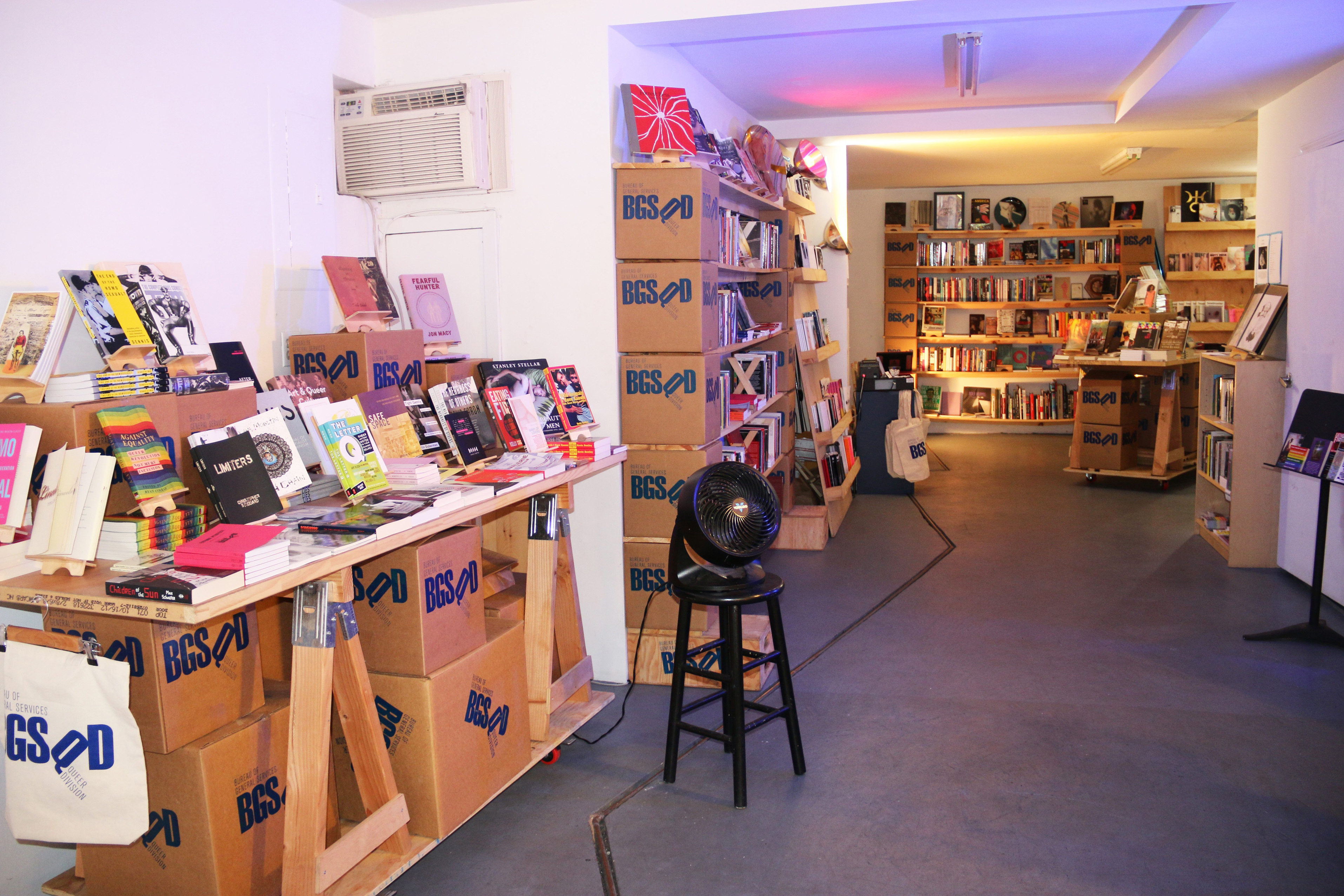 Located at The Bureau of General Services — Queer Division (BGSQD) on Hester Street, these workshops took place in what is usually a bookstore. Upon entering, I was tickled to peruse such titles as “The Hunger Gays” and something with “Dykenstein” in its name. But in this case, tables and bookshelves were pushed aside to clear enough space to move in, and thick mats were laid down.
Located at The Bureau of General Services — Queer Division (BGSQD) on Hester Street, these workshops took place in what is usually a bookstore. Upon entering, I was tickled to peruse such titles as “The Hunger Gays” and something with “Dykenstein” in its name. But in this case, tables and bookshelves were pushed aside to clear enough space to move in, and thick mats were laid down.
The BGSQD is hosted by Cage, a community-based arts organization. “It’s a queer book store, a cultural center and an event space. We do everything from book launches to poetry readings to film screenings,” said founder Greg Newton. “This is exactly what we want people to do with the space,” he said of these workshops.
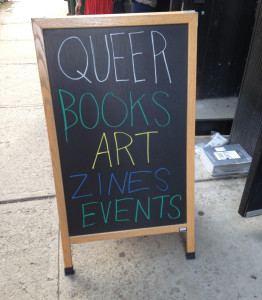 Organizer Li Cata based this series of workshops, he said, “on ClassClassClass, a community-based workshop which features artists teaching artists.” Unlike many teaching institutions for dance in NYC which prioritize dance “technique” — the memorization and perfection of specific movements and phrases — ClassClassClass “feels more like being in rehearsal,” said Li. “It’s like being a part of someone’s process… It’s about inviting someone into your brain.” Indeed, many of the workshops did feel more like being in someone’s rehearsal than like being in a typical dance technique class.
Organizer Li Cata based this series of workshops, he said, “on ClassClassClass, a community-based workshop which features artists teaching artists.” Unlike many teaching institutions for dance in NYC which prioritize dance “technique” — the memorization and perfection of specific movements and phrases — ClassClassClass “feels more like being in rehearsal,” said Li. “It’s like being a part of someone’s process… It’s about inviting someone into your brain.” Indeed, many of the workshops did feel more like being in someone’s rehearsal than like being in a typical dance technique class.
In the first workshop on Wednesday night, Melbourne and Brooklyn-based dance and performance artist Luke George led us through a series of open-ended group improvisations.
It was, he told us, “about the body.” The performing body, the sensory body, the tactile body. “I am interested,” said Mr. George, “in the connections between bodies.” In his work, he later told me, “I want to be dealing with the other beings who are in the room in that moment… acknowledging and being with them as who we/they are… To BE with ourselves and each other, to invite the possibilities of alternative intimacies and a kind of radical empathy.”
At one point, he split us into three groups. The first group was instructed to begin moving immediately based on their impulses, interests and curiosities given the environment of the room. The second group was told to enter after a set amount of time into the improvisation given what the first group was doing. Then groups one and two were told to stop and the third group was instructed to speak aloud a string of stream-of-consciousness statements beginning with “I see.” Later we were guided in similar exercises to make stream-of-consciousness statements beginning with “I feel,” and then lastly, “I know.”
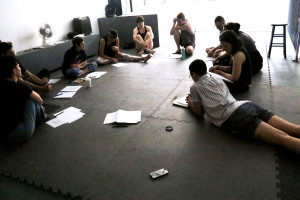 At the beginning of the workshop as we sat in a circle, Mr. George asked us to state our names and what we were interested in at that moment. Answers varied wildly from “extremism” to “circles… big ones; small ones…”
At the beginning of the workshop as we sat in a circle, Mr. George asked us to state our names and what we were interested in at that moment. Answers varied wildly from “extremism” to “circles… big ones; small ones…”
The improvisational scores that followed reflected that diversity of interest. I found myself somersaulting endlessly in one corner while another participant banged rhythmically on a metal railing accompanying another’s percussive stomping and yet another’s quiet humming. Together we wandered through moments of cacophony, stillness, contact, solo exploration, and interpersonal connection.
On Friday morning, dance, costume and installation artist Mariana Valencia led us in a practice she referred to as “On The Floor.” “It’s my practice of objects and bodies and collective thought,” she told me.
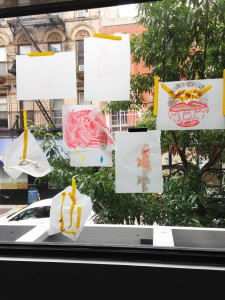 When I walked in the floor was sprinkled with objects. Colored pencils, sunglasses, a pocket etch-a-sketch, candy that she encouraged us to eat, nail polish, and tracing paper which soon was covered in ridiculous drawings made from lipstick and electrical tape.
When I walked in the floor was sprinkled with objects. Colored pencils, sunglasses, a pocket etch-a-sketch, candy that she encouraged us to eat, nail polish, and tracing paper which soon was covered in ridiculous drawings made from lipstick and electrical tape.
By the end of two hours string hung from the light fixtures bisecting the space with a ridiculous spider web, and we had erected a statue out of shoes, starched jeans, a chair sporting someone’s vest and a hat-wearing broom.
When I asked Mariana after her workshop, “What is queer performance?” she answered, “fluidity.” Then, after a pause, “fluidity… between…” —she held out flexed hands, elbows bent to ninety degrees and pinned to her torso— “this.” Meaning, I think, fluidity between social confines, fluidity within partitioned physical and nonphysical spaces, or perhaps, fluidity of nonmaterial things within the concreteness of physical reality. “The fluidity inside of structure,” she concluded.
This notion of fluidity came up several times when I asked some of the workshop leaders if they considered themselves to be “queer artists.”
Mariana told me: “I am queer and my skin is brown. I am not necessarily an artist who only focuses on these signifiers. I practice fluidity between these and hundreds of other signifiers, being a woman, an American, a midwesterner, a person who likes color, a traveler, a fear seeker… many signifiers. I am not a “queer artist” but I look to queer.”
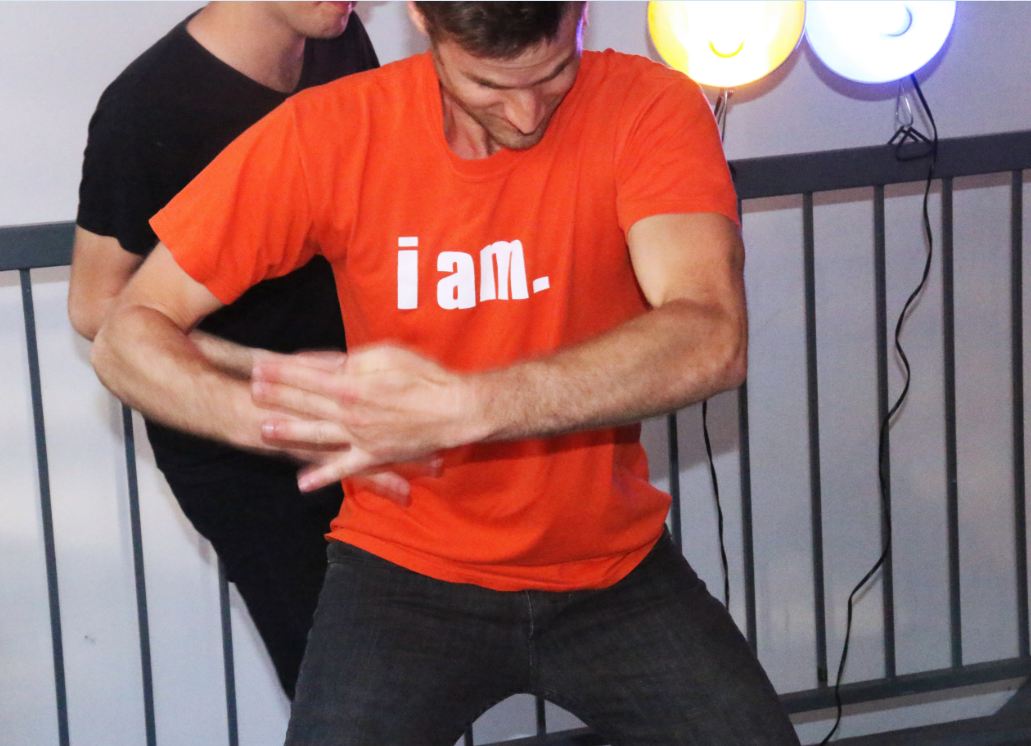 Luke George said, “I am queer. I have been queer for as long as I can remember. I am an artist. I have been making and performing things for as long as I can remember. I am also lots of other things like cis-gendered male, hairy, Australian, Tasmanian, of English Irish and Middle Eastern Ancestry… 35, dancer, performer, maker, semi-vegerarian, youngest of 3 brothers, a constant traveler, exploring the worlds of artist/gay/queer/radical faerie/body-based touch and energetic practices…. Amongst everything that I am I am also queer. But I’m confused about calling myself a queer artist…”
Luke George said, “I am queer. I have been queer for as long as I can remember. I am an artist. I have been making and performing things for as long as I can remember. I am also lots of other things like cis-gendered male, hairy, Australian, Tasmanian, of English Irish and Middle Eastern Ancestry… 35, dancer, performer, maker, semi-vegerarian, youngest of 3 brothers, a constant traveler, exploring the worlds of artist/gay/queer/radical faerie/body-based touch and energetic practices…. Amongst everything that I am I am also queer. But I’m confused about calling myself a queer artist…”
In Tatyana Tenenbaum’s workshop, I felt I was given the physical and sensory experience of the fluidity and multiplicity that Mariana and Luke used to describe queer (or any) identity. A conservatory-trained musician and composer as well as a movement artist, Tatyana led us through a series of exercises and improvisational scores intended to fuse sound, sensation, movement and vocalization. We were working with “crossing modalities,” she told us. Cross-wiring our sorting of sensory information and cross-referencing ways of perceiving and ways of knowing.
The result was potentially the most unique and engaging score I experienced in this whole series. I traced my spread fingers through the air because of the sound of the fan blowing through the room. I hummed because of the sensation of the puffy mats against my bare feet. I interacted with other bodies in the space as fluidly as if they were my other limbs.
Yet when it came to putting the queerness of it into language, Tatyana, like almost all of the artists I spoke to, was vehemently opposed.
“What is queer performance?” I asked Tatyana. “Oh no…” she answered, “… don’t ask me that.”
Though the name of this series, “What Is Queer Performance,” suggests the desire for a singular answer, anyone with even a basic level of experience with queer theory would know that this is impossible. “It’s not one definition,” said Mariana.
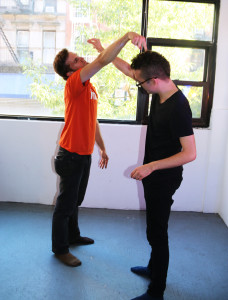 Elliott Jenetopulos, a participant in one of the workshops, said, “It is an important question to ask, but it doesn’t have a singular specific definition.”
Elliott Jenetopulos, a participant in one of the workshops, said, “It is an important question to ask, but it doesn’t have a singular specific definition.”
In regards to his name choice for this workshop series, Li expressed both a strong desire to name the queerness he has been witnessing recently in performance, —“to call it out”— and also, a hesitancy, a reluctance to do so.
He has been seeing performances and taking classes that read so clearly to him as queer, and that resonate so firmly with queer texts and queer theory. “I do really need to know,” he said. “Are they conscious about what they’re doing or not?”
One hope he expressed to me was that the people who became teaching artists would ask themselves: “am I making queer performance?” “If it wasn’t a question before,” said Li, “maybe it’ll be a question now.” In this effort, he was unquestionably successful.
Tatyana told us at the beginning of her workshop that Li’s question, “What Is Queer Performance” had sparked some interesting introspection and dialogue for her.
Luke said, “It’s surprisingly a fairly new question I’m asking myself… So far in my work I don’t think I’ve been conscious of having an intention to make queer art. But being curated in this lens has made me look at my work in that way and I’m starting to see how that may be possible…
“In my work I am dealing with myself, my body as who I am, everything that I am, that it’s there on stage, being with myself and with my audiences… Within this I can see how my body, my queer body, my queer being is at the forefront of my work.”
“There does seem to be this important distinction,” remarked Li, “if something is spoken or unspoken or when it’s spoken and how it’s spoken or unspoken.…It does feel like one of those things — like, once you name it, you ruin it. I have questions about this series. Am I adding to the history or taking away from it? —By naming it.”
When in a movement do you name a thing? And when you name it does that mean it’s over?
Memorably a friend once joked to me: “If my Mom knows about Postmodernism, it’s dead.” Likewise, Rob Horning’s seminal 2009 PopMatters article “The Death of the Hipster” described a panel discussion at the New School about the hipster — who he was when he still lived. As much as this event sought to investigate and define the hipster it also, in its mere existence, proclaimed him dead.
If we name queer performance… and if we define it… and if I tell my mom about it…does that mean it’s already over? Did we kill Queer Performance?
If we “call it out” as Li wanted to, do we transform a living movement into an archived one — an academic subject?
For some, the very definition of queer is so steadfastly connected with multiplicity, and vested so throughout in anti-definition, that its codification is unwanted.
“I think queer performance seeks to not be found,” Mariana asserted. “In some instances ‘queerness’ has been aestheticized, which I think is silly, since it’s free of landing anywhere. Queerness is always in movement.”
Elliott Jenetopolous had a more optimistic take: “The more often we ask ‘What Is Queer Performance,’ the more answers we will find. Part of the power of queer performance comes from its ability to shift and change and be so many things simultaneously.”
“What Is Queer Performance,” we seem to all agree, is an important question to ask. And an important question, at least for the moment, to refuse to answer.

